
Sir William Chambers was a Swedish-Scottish architect, based in London. Among his best-known works are Somerset House, and the pagoda at Kew. Chambers was a founder member of the Royal Academy.

The Bank of Scotland plc is a commercial and clearing bank based in Edinburgh, Scotland, and is part of the Lloyds Banking Group. The bank was established by the Parliament of Scotland in 1695 to develop Scotland's trade with other countries, and aimed to create a stable banking system in the Kingdom of Scotland.

George Square is the principal civic square in the city of Glasgow, Scotland. It is one of six squares in the city centre, the others being Cathedral Square, St Andrew's Square, St Enoch Square, Royal Exchange Square, and Blythswood Square on Blythswood Hill.
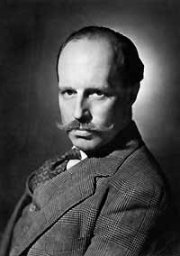
Sir Basil Urwin Spence, was a Scottish architect, most notably associated with Coventry Cathedral in England and the Beehive in New Zealand, but also responsible for numerous other buildings in the Modernist/Brutalist style.

David BryceFRSE FRIBA RSA was a Scottish architect.
The New Town is a central area of Edinburgh, the capital of Scotland. It was built in stages between 1767 and around 1850, and retains much of its original neo-classical and Georgian period architecture. Its best known street is Princes Street, facing Edinburgh Castle and the Old Town across the geological depression of the former Nor Loch. Together with the West End, the New Town was designated a UNESCO World Heritage Site alongside the Old Town in 1995. The area is also famed for the New Town Gardens, a heritage designation since March 2001.

Edinburgh: The New Town Church of Scotland serves Edinburgh's New Town, in Scotland. It is a congregation of the Church of Scotland, formed on 1 February 2024 by the union of St Andrew's & St George's West and Greenside Church.
Sir William Hardie Kininmonth was a Scottish architect whose work mixed a modern style with Scottish vernacular.
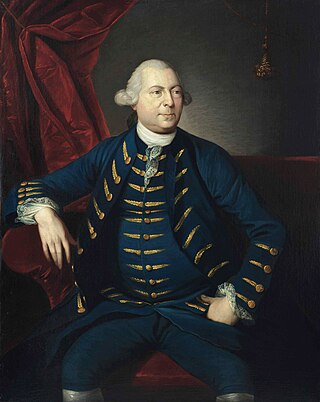
Sir Lawrence Dundas, 1st Baronet was a Scottish merchant, politician and planter.

The Royal Bank of Scotland is a major retail and commercial bank in Scotland. It is one of the retail banking subsidiaries of NatWest Group, together with NatWest and Ulster Bank. The Royal Bank of Scotland has around 700 branches, mainly in Scotland, though there are branches in many larger towns and cities throughout England and Wales. The bank is completely separate from the fellow Edinburgh-based bank, the Bank of Scotland, which pre-dates the Royal Bank by 32 years. The Royal Bank of Scotland was established to provide a bank with strong Hanoverian and Whig ties.

St Andrew Square is a garden square in Edinburgh, Scotland located at the east end of George Street.

John Dick Peddie was a Scottish architect, businessman and a Liberal Party politician.
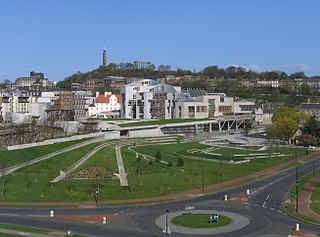
The architecture of Scotland includes all human building within the modern borders of Scotland, from the Neolithic era to the present day. The earliest surviving houses go back around 9500 years, and the first villages 6000 years: Skara Brae on the Mainland of Orkney being the earliest preserved example in Europe. Crannogs, roundhouses, each built on an artificial island, date from the Bronze Age and stone buildings called Atlantic roundhouses and larger earthwork hill forts from the Iron Age. The arrival of the Romans from about 71 AD led to the creation of forts like that at Trimontium, and a continuous fortification between the Firth of Forth and the Firth of Clyde known as the Antonine Wall, built in the second century AD. Beyond Roman influence, there is evidence of wheelhouses and underground souterrains. After the departure of the Romans there were a series of nucleated hill forts, often utilising major geographical features, as at Dunadd and Dunbarton.
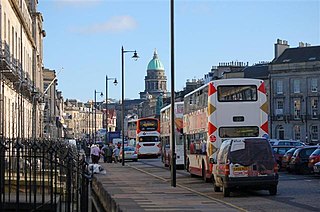
The West End is an affluent district of Edinburgh, Scotland, which along with the rest of the New Town and Old Town forms central Edinburgh, and Edinburgh's UNESCO World Heritage Site. The area boasts several of the city's hotels, restaurants, independent shops, offices and arts venues, including the Edinburgh Filmhouse, Edinburgh International Conference Centre and the Caledonian Hotel. The area also hosts art festivals and crafts fairs.
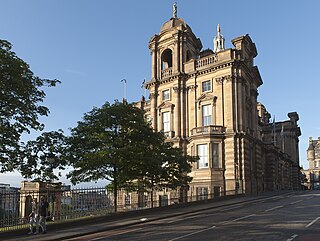
The Museum on the Mound is a museum in Edinburgh, Scotland, that focuses on money, coinage and economics. It is located in the Bank of Scotland Head Office building on The Mound. It has more than 50,000 visitors per year.
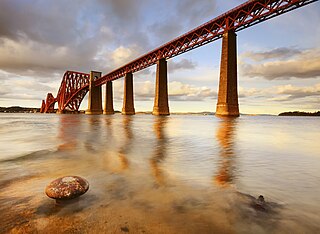
Architecture of Scotland in the Industrial Revolution includes all building in Scotland between the mid-eighteenth century and the end of the nineteenth century. During this period, the country underwent an economic and social transformation as a result of industrialisation, which was reflected in new architectural forms, techniques and scale of building. In the second half of the eighteenth century, Edinburgh was the focus of a classically inspired building boom that reflected the growing wealth and confidence of the capital. Housing often took the form of horizontally divided tenement flats. Some of the leading European architects during this period were Scottish, including Robert Adam and William Chambers.

Charles George Hood Kinnear FRIBA ARSA FRSE was one half of Peddie & Kinnear partnership, one of Scotland’s most renowned and prodigious architectural firms. They were noted for their development of the Scots Baronial style, typified by Cockburn Street in Edinburgh, which evokes a highly medieval atmosphere. Kinnear was also a pioneer photographer credited with inventing the bellows attachment on early cameras.

The Royal Bank of Scotland £1 note is a sterling banknote. The current cotton note, first issued in 1987, bears an image of Lord Ilay, one of the founders of the bank, on the obverse, and a vignette of Edinburgh Castle on the reverse.

The Melville Monument is a large column in St Andrew Square, Edinburgh constructed between 1821 and 1827 as a memorial to Scottish statesman Henry Dundas, 1st Viscount Melville.





















